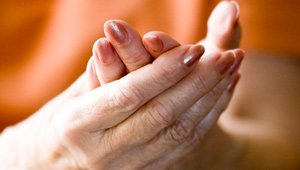
With the sudden tragic death of Robin Williams and his wife’s revelation that he was suffering from the early stages of Parkinson disease, this common, progressive neurologic disorder is back in the news. And it is common—approximately 1 percent of persons aged 60 or older will develop it. Both Mao Zedong and James Doohan (Scotty of “Star Trek”) died with the disease, and celebrities such as Michael J. Fox and Muhammad Ali continue to live with it.
What causes Parkinson disease?
The mean age at diagnosis is 70, so Parkinson disease is primarily, but not solely, a disease of the elderly. The cause is a degenerative process affecting nerves within an area of the brain called the basal ganglia. The basal ganglia is associated with depletion of the chemical neurotransmitter dopamine. This process decreases input to other areas of the brain, notably those that affect movement, leading to the typical symptoms of Parkinson disease. What starts this degenerative process in motion is unclear, although many theories are being studied today. Most cases are sporadic—they have no clear-cut genetic basis and, with a small number of exceptions, are not inherited from family members.
What are the symptoms?
The classic symptoms of Parkinson disease are:
- Tremor – A resting tremor, unlike the more common benign tremor that we see when someone reaches for a cup of coffee and the cup rattles in its dish. Clinicians look for this tremor in the tongue and in the fingers. Resting finger tremors look like the patient is rolling a pill between his or her fingers while the hand is comfortably resting on the lap.
- Bradykinesia – This term means slowness of movement, and is most typically manifested as a decrease in manual dexterity (for example, a dramatic change in handwriting so that the letters are small and scrunched together) and a shuffling gait while walking.
- Rigidity – Parkinson disease prevents the muscles from relaxing properly, and this can lead to stiffness and pain.
- Postural Instability – The inability to hold a posture tends to occur later in the disease than these other features, but can lead to falls and fractures.
What are the other effects of the disease?
Although primarily thought of as a motor disorder, Parkinson has many non-motor features as well, including:
- Sleep disorders
- Altered mood (depression and anxiety are common)
- Altered cognition (there is an increased incidence of dementia associated with Parkinson disease)
- Psychosis (hallucinations and delusions)
- Fatigue
- Dysfunction of the autonomic nervous system, which can lead to gastrointestinal and urinary issues as well as a severe drop in blood pressure when the patient stands up—also a contributor to the risk of falling
Does the disease get worse?
Unfortunately, the disease is progressive. At five years, about 25 percent of patients are disabled or have died, and by 10 years, the number is close to 80 percent. Some patients, however, do well and have only minimal disability even 20 years out. However, the disease appears to have little impact on overall life expectancy—presumably because it is largely a disease of the elderly.
Are there any treatments?
If you’ve seen the Robin Williams movie, “Awakenings,” you know there is a treatment for the disease. L-dopa is a medication that the body converts into dopamine, giving patients the neurotransmitter they lack and dramatically improving their quality of life. However, when L-dopa is converted to dopamine elsewhere in the body, like in the liver, it can lead to severe side effects such as nausea, vomiting, and a significant drop in blood pressure. Therefore, doctors prescribe L-dopa in combination with a second medication that blocks this peripheral conversion. In the US, this combination is known as Sinemet.
We also have other drugs that can mimic the effects of dopamine, and others to help manage the symptoms when they become particularly disabling.
Is there a cure?
Unfortunately, we don’t have a drug that significantly slows the neuronal degeneration that is the hallmark of the disease, so we currently cannot make a meaningful dent in its progression. The disease will eventually overcome even our best efforts to manage it with Sinemet and other drugs.
However, given close clinical supervision and the help of a team, including primary care providers, neurologists, physical therapists, occupational therapists, and more, most patients with Parkinson can expect to live close to a normal life expectancy with years of good quality of life. The picture certainly isn’t yet a rosy one, but we have come a long way in understanding the disease and managing—at least for several years—many of its complications.
The One Medical blog is published by One Medical, a national, modern primary care practice pairing 24/7 virtual care services with inviting and convenient in-person care at over 100 locations across the U.S. One Medical is on a mission to transform health care for all through a human-centered, technology-powered approach to caring for people at every stage of life.
Any general advice posted on our blog, website, or app is for informational purposes only and is not intended to replace or substitute for any medical or other advice. 1Life Healthcare, Inc. and the One Medical entities make no representations or warranties and expressly disclaim any and all liability concerning any treatment, action by, or effect on any person following the general information offered or provided within or through the blog, website, or app. If you have specific concerns or a situation arises in which you require medical advice, you should consult with an appropriately trained and qualified medical services provider.
